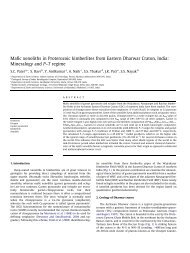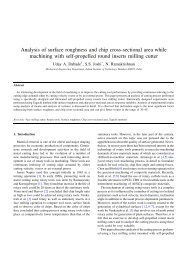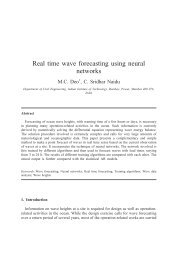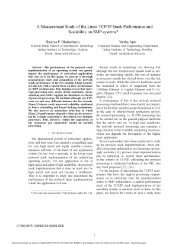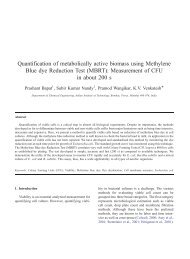Infrared signature studies of aerospace vehicles - DSpace at IIT ...
Infrared signature studies of aerospace vehicles - DSpace at IIT ...
Infrared signature studies of aerospace vehicles - DSpace at IIT ...
Create successful ePaper yourself
Turn your PDF publications into a flip-book with our unique Google optimized e-Paper software.
two c<strong>at</strong>egories <strong>of</strong> IR prediction models: (i) empirically<br />
based, and (ii) physics based. In the former, IR<br />
measurements are obtained on oper<strong>at</strong>ing aircraft <strong>at</strong><br />
multiple aspects and oper<strong>at</strong>ing conditions, and the<br />
d<strong>at</strong>a is analyzed to fill the gaps in prediction [13]. In<br />
the l<strong>at</strong>er, aircraft geometry, surface emissivity,<br />
temper<strong>at</strong>ure pr<strong>of</strong>ile, and surface reflections, are<br />
inputs to the model [13]. Experimental measurements<br />
<strong>of</strong> IRSL require an aircraft to be flown over<br />
predetermined p<strong>at</strong>h and oper<strong>at</strong>ing conditions,<br />
determined by H and M N. The majority <strong>of</strong> research<br />
in IR <strong>sign<strong>at</strong>ure</strong>s <strong>of</strong> <strong>aerospace</strong> <strong>vehicles</strong> is undertaken<br />
by military research establishments, rel<strong>at</strong>ive to<br />
academia. Therefore, there is a scarcity <strong>of</strong> details<br />
in the open liter<strong>at</strong>ure in both analysis and measurement<br />
techniques. Investig<strong>at</strong>ions using experimental<br />
measurements were very few and mostly made for<br />
plume IR <strong>sign<strong>at</strong>ure</strong> measurements. About 10–12<br />
standard IRSL prediction models, based on a blend<br />
<strong>of</strong> analysis and experimental measurement techniques<br />
were developed worldwide. However, the<br />
underlying physics <strong>of</strong> these models and their<br />
prediction efficiency is kept under wrap. Due to<br />
difficulties in arranging experimental measurements,<br />
standalone analyses methods are preferred; as they<br />
involve less infrastructure, external dependencies,<br />
and cost. Analytical prediction methods are much<br />
less expensive, but less accur<strong>at</strong>e compared to<br />
experimental measurements due to uncertainties in<br />
input parameters. Valid<strong>at</strong>ion with experimental<br />
measurements and subsequent improvement makes<br />
analytical models more accur<strong>at</strong>e. Such models are<br />
immensely useful in digital simul<strong>at</strong>ors and for the<br />
design <strong>of</strong> aircraft stealthy with respect to IRSL.<br />
Experimental valid<strong>at</strong>ion <strong>of</strong> analytical work has been<br />
undertaken by standard IRSL prediction model<br />
developers; e.g. NIRATAM, SIRUS, etc. The<br />
NIRATAM is valid<strong>at</strong>ed and developed using field<br />
measurements on Tornado, European F-16, F-4,<br />
Mirage, and F-104 [92].<br />
The major shortcomings <strong>of</strong> the analysis methods<br />
can be summarized as follows:<br />
(a) Analysis methods/models are inherently inaccur<strong>at</strong>e<br />
due to uncertainties in input parameters,<br />
unless they are valid<strong>at</strong>ed by experimental<br />
measurements.<br />
(b) Because analysis methods are developed in<br />
modules, there can be errors resulting from<br />
coupling between modules. As an illustr<strong>at</strong>ion,<br />
the aircraft rear fuselage is also he<strong>at</strong>ed by the<br />
plume, in addition to internal he<strong>at</strong>ing by an<br />
ARTICLE IN PRESS<br />
embedded gas turbine engine and external by<br />
aerodynamic he<strong>at</strong>ing. Therefore, consider<strong>at</strong>ion<br />
<strong>of</strong> exhaust plume orient<strong>at</strong>ion is also important<br />
for IRSL prediction from the rear fuselage skin.<br />
(c) Prediction <strong>of</strong> IRSL from the engine also<br />
involves several miscellaneous parameters, e.g.<br />
engine throttle setting, cooling system, and hot<br />
gas streaks [13].<br />
(d) Multiplicity <strong>of</strong> aircraft, diversity in aircraft<br />
mission planning, and availability <strong>of</strong> several<br />
IR-guided missiles, has increased the uncertainties<br />
in IRSL prediction models.<br />
4.5. Lock-on versus lethal envelope and target<br />
susceptibility<br />
233<br />
The lock-on envelope is defined as the locus <strong>of</strong><br />
points around a target where the missile’s IR seeker<br />
locks-on to the target; it has been used to evalu<strong>at</strong>e<br />
target susceptibility. Due to advances in IR<br />
detectors, missiles are generally constrained by their<br />
burn-out range; therefore, the lock-on envelope is<br />
inadequ<strong>at</strong>e for target susceptibility assessment. The<br />
lock-on envelope does not incorpor<strong>at</strong>e several other<br />
important parameters [100]; e.g. target aircraft (Vac)<br />
and missile (Vm) velocities, missile burn-out range,<br />
etc. The lethal envelope [100] is the locus <strong>of</strong> points<br />
around the target aircraft, within which, if the<br />
missile is launched, there is a high probability <strong>of</strong> the<br />
missile hitting the target. The lethal envelope is a<br />
function <strong>of</strong> target aircraft lock-on envelope, target<br />
aircraft velocity, missile burn-out range, missile<br />
blast-kill radius, etc. Fig. 13(a) shows the 2-D lockon<br />
and lethal envelope plots for military aircraft; for<br />
which, it is assumed th<strong>at</strong> the target aircraft is an<br />
isotropic point source <strong>of</strong> IR radi<strong>at</strong>ion. Therefore,<br />
the lock-on range (RLO) is constant in all aspects;<br />
i.e. the lock-on envelope is a perfect circle. The<br />
<strong>at</strong>tacking and target aircraft are assumed to be in<br />
the same horizontal plane, and the target aircraft is<br />
assumed not to be taking any countermeasures<br />
against the approaching AAM. The vari<strong>at</strong>ion <strong>of</strong><br />
A lethal (area <strong>of</strong> lethal envelope) with R LO for<br />
different (V ac/V m)isinFig. 13(b). The curves with<br />
higher (Vac/Vm) have smaller Alethal, due to decrease<br />
in tracking r<strong>at</strong>e by the missile; i.e. an increase in Vac<br />
reduces Alethal, making the target aircraft less<br />
susceptible.<br />
It is <strong>of</strong> significance to find the threshold amount<br />
by which the target’s IRSL should be reduced, to<br />
achieve the desired reduction in its susceptibility.<br />
This enables gauging <strong>of</strong> the effectiveness <strong>of</strong> IRSS



